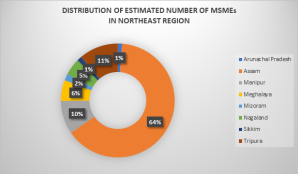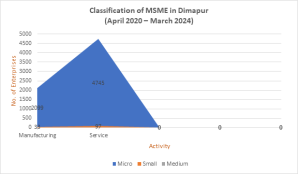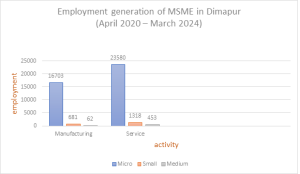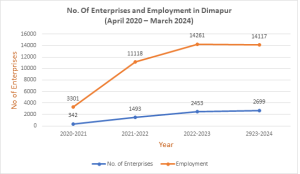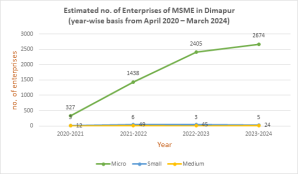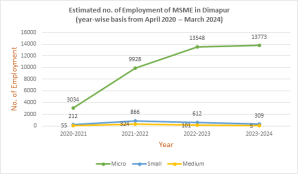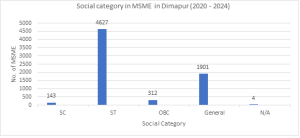The Role of the MSME Sector; Its Implicit Growth and Contribution to Entrepreneurship and Employment Generation in Dimapur, Nagaland
- Dr. J. Suresh Kumar
- Ms. Kutseilu Vese
- 2600-2615
- May 22, 2024
- Development Communication
The Role of the MSME Sector; Its Implicit Growth and Contribution to Entrepreneurship and Employment Generation in Dimapur, Nagaland
Dr. J. Suresh Kumar*1 and Ms. Kutseilu Vese2
1Associate Professor, Department of Economics, St. Joseph University,
Chümoukedima, Nagaland, India
2M.A Student, Department of Economics, St. Joseph University,
Chümoukedima, Nagaland, India
*Corresponding Author
DOI: https://dx.doi.org/10.47772/IJRISS.2024.804251
Received: 13 April 2024; Accepted: 20 April 2024; Published: 22 May 2024
ABSTRACT
MSMEs are important to the economy and have been shown to be particularly effective in eliminating poverty in the lowest-income regions as well as regional imbalances. This study’s primary goal is to evaluate the effectiveness and contribution of Micro, Small, and Medium-Sized Enterprises (MSMEs), which foster entrepreneurship and create jobs for a variety of people, thus boosting the economy’s growth on both a regional and national level. Through comprehensive analysis and empirical investigation, the study aims to uncover the implicit growth trajectories of the MSME sector and its significant contributions to entrepreneurial endeavours and the creation of sustainable employment avenues. By shedding light on these vital aspects, the research seeks to provide valuable insights for policymakers, stakeholders, and practitioners aimed at fostering economic development and fostering a conducive environment for MSME growth in the region. However, the total number of beneficiaries during the designated time frame is 443. The status of employment generation under the MSMEs is seen to be increasing at a rapid rate from 3301 in F.Y. 2020 -2021 to 14117 in F.Y. 2023 – 2024.
Keywords: Entrepreneurship, Employment Generation, Economic Development, Innovation, Financial Inclusion and Policy Advocacy
INTRODUCTION
The present scenario of the Micro, Small, and Medium Enterprises (MSMEs) sector is rising at its peak. Today, the MSMEs are emerging as one of the fastest growing sectors which contributes to the diversification of the economy by operating in various sectors including, manufacturing, trade, services, etc at the local level, contributing to the development of local supply chains and communities to the broader scope. This sector plays a pivotal role in fostering entrepreneurship development as well as generating employment opportunities on a large scale.
India as a whole is estimated to have over 633.9 lakh Micro, Small, and Medium Enterprises (MSMEs) in India. Out of which, the Micro sector holds about 630.5 lakh enterprises, which accounts to over 99% of the country’s total number of MSMEs. The small and medium sector consists of 3.3 lakh enterprises, and about 0.05 lakh enterprises (i.e., 0.5% and 0.01% of total MSMEs) respectively. Of the total MSMEs in the country, around 324.9 lakh enterprises (52.3%) are found in rural regions while 309 lakh enterprises (48.8%) are established in the urban regions. MSME consists of 36 million units, furnishing about 80 million people to employment and contributing about 8% to the country’s GDP.
Dimapur being referred to as the Gateway of Nagaland and reputed as the main growing commercial activities of the State is known to be a home to various Micro, Small, and Medium Enterprises by various inspiring individuals or groups of individuals which also holds a major role of MSMEs in generating employment opportunities as well as entrepreneurship development contributing to the growth of the economy as a whole. This may include generating income for the people, raising living standards, meeting daily needs and alleviating poverty at the local level, etc.
In addition, the Office of the Development Commissioner (MSME) has initiated a web-based application module, that is, My MSME with the aim to support various scheme beneficiaries. Through this, the entrepreneurs or the users can assess the application and track it through their mobile apps. (MSME Annual Report 2021 – 2022)
This study seeks to delve deeper into the multifaceted dimensions of the MSME sector in Dimapur, Nagaland, focusing on its implicit growth patterns and its significant contributions to entrepreneurship and employment generation. Understanding the dynamics of this sector in a specific context like Dimapur is essential not only for academic inquiry but also for informing policy decisions and strategic interventions aimed at bolstering economic development and sustainable livelihoods.
REVIEW OF LITERATURE
In areas such as Dimapur, and Nagaland, the Micro, Small, and Medium Enterprises (MSME) sector is vital for stimulating economic growth, encouraging entrepreneurship, and creating job opportunities. The research on the MSME sector’s function, implicit growth, and contributions to entrepreneurship and job creation in Dimapur, Nagaland, is summarised in this review of the literature.
Bhuyan’s (2019) research sheds light on the potential, growth prospects, and constraints faced by MSMEs in Nagaland, offering valuable insights into their dynamics. The study’s conclusions help to clarify Nagaland’s MSME environment, which lays the groundwork for additional research in Dimapur.
Kikon and Phom (2020) investigate the contribution of MSMEs to economic development, concentrating on Nagaland’s Dimapur town. Their case study informs the present study’s backdrop by shedding light on the unique contributions made by MSMEs to entrepreneurship and job creation in Dimapur.
While not specific to Dimapur or Nagaland, Longo and Onuche’s (2018) study offers valuable insights into the entrepreneurial challenges faced by MSMEs. Understanding these challenges can provide a comparative framework for analyzing the situation in Dimapur and identifying potential solutions.
Roy and Chakraborty’s (2017) review critically examines the role of MSMEs in employment generation in India. Even though the circumstances are different, the results provide light on the more general effects of MSMEs on employment generation, which may be helpful in determining how they affect Dimapur and Nagaland.
This evaluation of the literature establishes the framework for additional investigation into the function of the MSME sector in Dimapur, Nagaland, and its consequences for entrepreneurship and job creation in the area by combining these and other studies.
Statement of the Study
The purpose of this research is to investigate the function of the Micro, Small, and Medium-Sized Enterprises (MSME) sector in Dimapur, Nagaland, with particular attention on its underlying growth patterns and its roles in fostering entrepreneurship and creating jobs. Examine the present state of the MSME sector in Dimapur, Nagaland, taking into account its size, makeup, and distribution among different industries. Examine the development paths of MSMEs in Dimapur over a certain time frame, noting the critical elements influencing their resilience and growth. Evaluate how the MSME sector affects the growth of entrepreneurship by looking at how much it helps new businesses start and how much it encourages entrepreneurial endeavours. Examine the importance of MSMEs to job creation, skill development, and socioeconomic empowerment as you assess their role in creating employment possibilities in Dimapur, Nagaland.
Objectives of the Study
To study the current status and composition of the Micro, Small, and Medium-Sized Enterprises (MSME) sector in Dimapur, Nagaland.
To assess the growth trends and patterns of the MSME sector in Dimapur over a specified period of time.
To investigate how MSMEs support entrepreneurship in the Dimapur, Nagaland, area.
To assess the contribution of MSMEs to the employment and socioeconomic development of Dimapur, Nagaland.
To ascertain the challenges that Dimapur, Nagaland, and MSMEs must face in order to grow and make a difference.
To provide recommendations and action plans for enhancing the growth of the MSME sector and its socioeconomic advantages in Dimapur, Nagaland.
By completing these goals, the study hopes to offer insightful information about the workings of the MSME sector in Dimapur, Nagaland, and support well-informed policy decisions and targeted interventions that advance the region’s sustainable development and equitable economic growth.
RESEARCH METHODOLOGY
A research methodology is a means of technique and procedure that is used to identify and analyze the data on a specific research topic. The entire research is solely based on the secondary data. Secondary data is collected from various available resources such as published books, journals, internet websites, etc, and the office of the Ministry of MSME Dimapur. The information was gathered over the course of the last four years (2020–2024) in order to look into the development of entrepreneurship as well as the expansion and performance of Dimapur’s micro, small, and medium-sized businesses.
Current Status and Composition of the Micro, Small, and Medium Enterprises (MSME) Sector in Dimapur, Nagaland.
The MSMEs play a prominent role in the economy and are found to be very helpful in reducing regional imbalances and well as removing poverty in the lowest. Its significant contributions to entrepreneurial endeavors and the creation of sustainable employment avenues.
Table – 1 Distribution of Estimated Number of MSMEs in Northeast Region
| Sl. No. | State in Northeast | Estimated No. of Enterprises (in lakhs) | |||
| Micro | Small | Medium | MSME | ||
| 1 | Arunachal Pradesh | 0.22 | 0.00 | 0.00 | 0.23 |
| 2 | Assam | 12.10 | 0.04 | 0.00 | 12.14 |
| 3 | Manipur | 1.80 | 0.00 | 0.00 | 1.80 |
| 4 | Meghalaya | 1.12 | 0.00 | 0.00 | 1.12 |
| 5 | Mizoram | 0.35 | 0.00 | 0.00 | 0.35 |
| 6 | Nagaland | 0.91 | 0.00 | 0.00 | 0.91 |
| 7 | Sikkim | 0.26 | 0.00 | 0.00 | 0.26 |
| 8 | Tripura | 2.10 | 0.01 | 0.00 | 2.11 |
| Total | 18.64 | 0.05 | 0.00 | 18.69 | |
Source: NSS 73rd round, 2015-2016
Table 1 shows the distribution of the estimated number of MSMEs in the Northeast region of India. As can be seen from the table, Assam dominates the MSMEs among the entire northeast region with 12.14 lakh enterprises (with 12.10 and 0.04 in Micro and Small enterprises respectively) followed by Tripura with 2.11 lakh enterprises (2.10 and 0.01 in Micro and Small enterprises respectively). The medium enterprises are nil in all the Northeast states of India. This is also shown in the figure below:
Table – 2 Distribution of Employees in North East Region
| Sl. No. | State in North-East | Estimated number of Employment | ||
| Female | Male | Total | ||
| 1 | Arunachal Pradesh | 0.11 | 0.29 | 0.41 |
| 2 | Assam | 1.78 | 16.37 | 18.15 |
| 3 | Manipur | 1.40 | 1.52 | 2.92 |
| 4 | Meghalaya | 0.72 | 1.19 | 1.91 |
| 5 | Mizoram | 0.28 | 0.34 | 0.62 |
| 6 | Nagaland | 0.59 | 1.18 | 1.77 |
| 7 | Sikkim | 0.14 | 0.31 | 0.45 |
Source: NSS 73rd Round, 2015-2016
The distribution of employment of the Northeastern states in the MSME sector explains the employment generation and attachment of workers to the jobs. Table 2 shows the distribution of employees in the Northeast states of India. Here, the states of Assam, Manipur, and Tripura have the highest total number of employees in the MSMEs sector with 18.15, 2.92, and 2.95 respectively. The state of Assam is majorly employed by males with 16.37 compared to females with 1.78. The state of Arunachal Pradesh and Sikkim has the lowest number of employees with a total of 0.41 and 0.45 respectively in the MSME sector. Overall, the Northeastern states occupy 29.18 of the total number of the country. The same is depicted in the figure below:
Growth Patterns and Trends of The MSME Sector in Dimapur
The study explores the dynamic trajectory of small-scale enterprises in the region and looks at the growth patterns and trends of the Micro, Small, and Medium Enterprises (MSME) sector in Dimapur. The report finds implicit growth patterns in the MSME sector through in-depth investigation, which are defined by existing businesses’ innovation and progressive expansion. This increase is shown to be influenced by elements like financial accessibility, governmental frameworks that are supportive, and technology advancements.
Table – 3 Classification of MSME in Dimapur (April 2020 – March 2024)
| Activity | No. of Enterprises | |||
| Micro | Small | Medium | Total | |
| Manufacturing | 2099 | 33 | 3 | 2135 |
| Service | 4745 | 97 | 10 | 4852 |
| Total | 6844 | 130 | 13 | 6987 |
Source – MSME Report (April 2020 – March 2024)
The MSME categorization in Dimapur (April 2020 – March 2024) is displayed in Table 3 above. There are 6987 MSMEs in Dimapur overall, according to the MSME report (2020–2024). The majority of these, or 6844, are Micro-enterprises (97.95%), followed by Small and Medium-Sized Enterprises (i.e., 120 and 13 respectively; 1.86 percent and 0.18%, respectively). With 69.44% of all MSMEs and 30.56% of all companies coming under the manufacturing category, the service sector leads all other Micro, Small, and Medium-Sized companies. The figure below illustrates this as well.
Contribution of MSMEs to Employment Generation and Socio-Economic Development
The important role that micro, small, and medium-sized enterprises (MSMEs) play in the local economy is highlighted by a study on how these businesses contribute to the creation of jobs and socio-economic development in Dimapur, Nagaland. Furthermore, MSMEs are essential for promoting inclusive growth and igniting the local economy.
Table – 4 Employment Generation of MSME in Dimapur (April 2020 – March 2024)
| Activity | Employment | |||
| Micro | Small | Medium | Total | |
| Manufacturing | 16703 | 681 | 62 | 17446 |
| Service | 23580 | 1318 | 453 | 25351 |
| Total | 40283 | 1999 | 515 | 42797 |
Source – MSME Report (April 2020 – March 2024)
The above table 4 represents the employment generation of MSMEs in Dimapur (April 2020 – March 2024). It is evident from the above that the majority of the employment is generated through Micro Enterprises (94.12%), followed by 4.67% in small enterprises and about 1.2% are employed under Medium Enterprises. Of the total employment generation, Service activities constitute the majority of 59.23% and manufacturing 40.77%. Medium enterprises played the least role in generating employment (1.2%) in both Manufacturing and Service activity. The figure below shows the graphical representation of employment generation under MSMEs in Dimapur.
Table – 5 No. of Enterprises and Employment in Dimapur (April 2020 – March 2024)
| Year | No. of Enterprises | Employment |
| 2020 – 2021 | 342 | 3301 |
| 2021 – 2022 | 1493 | 11118 |
| 2022 – 2023 | 2453 | 14261 |
| 2023 – 2024 | 2699 | 14117 |
| Total | 6987 | 42797 |
Source – MSME Report (April 2020 – March 2024)
The above Table 5 represents the total number of enterprises and employment generated from April 2020 – March 2024. It is evident from the above reported data, that there is a significant growth of MSME in Dimapur from 2020 till 2024. The figure below shows the trend of enterprises and employment generation during 2020 – 2024. The figure below shows the positive growth of enterprises in Service activity with year while the Manufacturing activity slightly declined in the F.Y 2023 – 2024 under Micro enterprises. However, there is a fluctuating growth of enterprises in both the medium and small enterprises. The status of employment generation under the MSMEs is seen to be increasing at a rapid rate from 3301 in F.Y. 2020 -2021 to 14117 in F.Y. 2023 – 2024.
Table – 6 provides insights into the estimated number of Micro, Small, and Medium Enterprises (MSMEs) in Dimapur, categorized by activity (Manufacturing and Service) on a year-wise basis from April 2020 to March 2024. From 2020 to 2021, the total number of MSMEs in Dimapur was 342, with 120 engaged in manufacturing and 222 in services. The majority of these were micro-enterprises, followed by a smaller number of small and medium enterprises. Moving to 2021-2022, there was a noticeable increase in the total number of enterprises, reaching 1493. The manufacturing sector saw a significant rise to 466, while the service sector also experienced growth, reaching 1027 enterprises. This trend reflects a substantial expansion of MSME activity within Dimapur. In 2022-2023, the upward trajectory continued, with a total of 2453 MSMEs. Manufacturing enterprises increased to 780, while service enterprises rose to 1673. Interestingly, while there was a decrease in the number of small and medium enterprises in manufacturing, overall growth in the sector remained strong. Finally, in 2023-2024, there was a slight decline in the total number of MSMEs, totalling 2699. Despite this, both manufacturing and service sectors maintained relatively stable numbers compared to the previous year. This could indicate a consolidation phase after periods of rapid growth in the preceding years. Overall, the data suggests a positive trend in MSME growth in Dimapur over the years, particularly in the service sector, indicating a potentially thriving business environment and economic activity within the region.
Table – 6 Estimated No. of Enterprises of MSME in Dimapur (year-wise basis from April 2020 – March 2024)
| Year | Activity | No. of Enterprises | Total | ||
| Micro | Small | Medium | |||
| 2020 – 2021 | Manufacturing | 116 | 3 | 1 | 120 |
| Service | 211 | 9 | 2 | 222 | |
| Total | 327 | 12 | 3 | 342 | |
| 2021 – 2022 | Manufacturing | 446 | 19 | 1 | 466 |
| Service | 992 | 30 | 5 | 1027 | |
| Total | 1438 | 49 | 6 | 1493 | |
| 2022 – 2023 | Manufacturing | 774 | 6 | 0 | 780 |
| Service | 1631 | 39 | 3 | 1673 | |
| Total | 2405 | 45 | 3 | 2453 | |
| 2023 – 2024 | Manufacturing | 763 | 5 | 1 | 769 |
| Service | 1911 | 19 | 0 | 1930 | |
| Total | 2674 | 24 | 1 | 2699 | |
Source – MSME Report (April 2020 – March 2024)
Table – 7 presents estimates of employment within Micro, Small, and Medium Enterprises (MSMEs) in Dimapur, categorized by activity (Manufacturing and Service) on a year-wise basis from April 2020 to March 2024. In the fiscal year 2020-2021, the total estimated employment in MSMEs in Dimapur stood at 3,301, with the majority employed in the service sector (2,018) compared to manufacturing (1,283). Within manufacturing, micro-enterprises employed the most individuals, followed by small and medium enterprises. Similarly, in the service sector, micro-enterprises dominated in terms of employment. Moving to 2021-2022, there was a substantial increase in total employment, reaching 11,118. Both manufacturing and service sectors experienced significant growth in employment. Manufacturing saw a jump to 4,965, while service employment soared to 6,153. Again, micro-enterprises employed the most individuals across both sectors. In 2022-2023, total employment continued to rise, reaching 14,261. While manufacturing employment slightly decreased, service employment continued to grow. This period saw a significant rise in employment within micro-enterprises across both sectors. Finally, in 2023-2024, total employment remained relatively stable at 14,117. Although manufacturing employment decreased slightly, service employment maintained its upward trend. Micro-enterprises remained the primary source of employment, particularly in the service sector.
Overall, the data indicates a positive trend in employment within MSMEs in Dimapur over the years, with significant growth observed, especially in the service sector. This suggests a potential increase in economic activity and job opportunities within the region, reflecting a thriving MSME sector.
Table – 7 Estimated No. of Employment of MSME in Dimapur (year-wise basis from April 2020 – March 2024)
| Year | Activity | Employment | Total | ||
| Micro | Small | Medium | |||
| 2020 – 2021 | Manufacturing | 1205 | 63 | 15 | 1283 |
| Service | 1829 | 149 | 40 | 2018 | |
| Total | 3034 | 212 | 55 | 3301 | |
| 2021 – 2022 | Manufacturing | 4596 | 357 | 12 | 4965 |
| Service | 5332 | 509 | 312 | 6153 | |
| Total | 9928 | 866 | 324 | 11118 | |
| 2022 – 2023 | Manufacturing | 5458 | 172 | 0 | 5630 |
| Service | 8090 | 440 | 101 | 8631 | |
| Total | 13548 | 612 | 101 | 14261 | |
| 2023 – 2024 | Manufacturing | 5444 | 89 | 35 | 5568 |
| Service | 8329 | 220 | 0 | 8549 | |
| Total | 13773 | 309 | 35 | 14117 | |
Source – MSME Report (April 2020 – March 2024)
Role of MSMEs in Fostering Entrepreneurship within the Local Community
The study emphasizes the critical role that MSMEs play in promoting entrepreneurial spirit and initiatives within the local community in Dimapur, Nagaland. MSMEs are classified as small, medium, and enterprise businesses. Furthermore, MSMEs foster an environment that is favorable to innovation and experimentation, which in turn encourages the development of new businesses and startups in the neighborhood.
Table – 8 Social Category in MSME in Dimapur (April 2020 – March 2024)
| Year | Social Category
|
Total | ||||
| ST | SC | OBC | General | N/A | ||
| 2020 – 2021 | 218 | 8 | 16 | 96 | 4 | 342 |
| 2021 – 2022 | 968 | 34 | 66 | 425 | 0 | 1493 |
| 2022 – 2023 | 1649 | 52 | 109 | 643 | 0 | 2453 |
| 2023 – 2024
|
1792 | 49 | 121 | 737 | 0 | 2699 |
| Total | 4627 | 143 | 312 | 1901 | 4 | 6987 |
Source – MSME Report (April 2020 – March 2024)
Table 8 above and Table 9 below show the distribution of social categories engaged in the MSME Sector in Dimapur as per the April 2020 – March 2024 report. Here, the ST category holds the majority of 4627 units against the total of 6987 units during the four periods F.Y followed by the General category with 1901 while SC and OBC hold the minimum units with 143 and 312 units respectively. The report also shows the growing status of the units by all the social categories except for SC which declined slightly from 52 units in 2022-2023 to 49 units in 2023 – 2024.
Table – 9 Social Category in MSME in Dimapur (2020 – 2024)
| Social Category | SC | ST | OBC | General | N/A | Total |
| No. of MSME | 143 | 4627 | 312 | 1901 | 4 | 6987 |
Source – MSME Report (April 2020 – March 2024)
Table -10 Organization Type of MSME in Dimapur (April 2020 – March 2024)
| Sl. No. | Organization Type | Years | Total | |||
| 2020-2021 | 2021-2022 | 2022-2023 | 2023-2024 | |||
| 1. | Co-operative | 2 | 0 | 3 | 1 | 6 |
| 2. | Hindu Undivided Family | 3 | 4 | 3 | 16 | 26 |
| 3. | Limited Liability Partnerships | 2 | 3 | 2 | 2 | 9 |
| 4. | Others | 10 | 88 | 180 | 154 | 432 |
| 5. | Partnerships | 8 | 25 | 30 | 36 | 99 |
| 6. | Private Limited Company | 14 | 25 | 30 | 40 | 109 |
| 7. | Proprietary | 290 | 1330 | 2187 | 2438 | 6245 |
| 8. | Public Limited Company | 0 | 2 | 1 | 2 | 5 |
| 9. | Self Help Groups | 1 | 5 | 3 | 3 | 12 |
| 10. | Society | 10 | 11 | 12 | 5 | 38 |
| 11. | Trust | 2 | 0 | 2 | 2 | 6 |
| Total | 342 | 1493 | 2453 | 2699 | 6987 | |
Source – MSME Report (April 2020 – March 2024)
The proprietary organization holds the major share of MSME Dimapur which accounts for % of the total MSME Dimapur. organizations such as Public Limited Companies, Trust, Limited Liability Partnerships, and Co-operative hold the least share in the MSME Dimapur. According to the MSME report, Organizations like Society and Self-Help Group Showed Negative growth throughout the year from 2020- 2024. In contrast to these organizations, Proprietary organization shows massive growth while Partnership organizations show steady positive growth.
Table – 11 No. of Trade wise UDYAM Registered (MSME) in Dimapur (April 2020 – March 2024)
| Sl. No. | Particulars | Years | Total | |||
| 2020-2021 | 2021-2022 | 2022-2023 | 2023-2024 | |||
| 1. | Mfg. Of Food Products & Beverages | – | 120 | 273 | – | 393 |
| 2. | Mfg. Of Textile | – | 18 | 268 | – | 286 |
| 3. | Mfg. Of Weaving Apparel | – | 19 | 59 | – | 78 |
| 4. | Training & Dressing of Leather | – | 13 | 10 | – | 23 |
| 5. | Mfg. Of Wood & Wood Products | – | 66 | 61 | – | 127 |
| 6. | Mfg. Of Paper & Paper Products | – | 5 | 4 | – | 9 |
| 7. | Publishing, Printing, Reproduction of Recorded Media | – | 8 | 98 | – | 106 |
| 8. | Retail/ Wholesale Trade | – | – | 974 | – | 974 |
| 9. | Land Transport & Transport Via Pipelines | – | – | 170 | – | 170 |
| 10. | Mining And Quarrying | – | – | 38 | – | 38 |
| 11. | Mfg. Of Coke, Refined Petroleum Products | – | N/A | 6 | – | 6 |
| 12. | Mfg. Of Chemical & Chemical Products | – | N/A | 19 | – | 19 |
| 13. | Mfg. Of Rubber and Plastic Products | – | 14 | 8 | – | 14 |
| 14. | Mfg. Of Non-Metallic | – | 92 | 11 | – | 92 |
| 15. | Mfg. Of Fabricated Metal Products | – | – | 14 | – | 14 |
| 16. | Mfg. Of Machinery &Equipment | – | – | 8 | – | 8 |
| 17. | Mfg. Of Electronic Machinery | – | – | 4 | – | 4 |
| 18. | Mfg. Of Motor Vehicle Trailers &Semi- Trailers | – | – | 4 | – | 4 |
| 19. | Mfg. Of Furniture | – | – | 63 | – | 63 |
| 20. | Maintenance & Repair of Motor Vehicles &Motor Cycles | – | – | 5 | – | 5 |
| 21. | Maintenance & Repair of Personal & Household Goods | – | – | 15 | – | 15 |
| 22. | Computer And Related Activities | – | – | 34 | – | 34 |
| 23. | Other Business Activities | – | – | 15 | – | 15 |
| 24. | Health &Social Work | – | – | 22 | – | 22 |
| 25. | Recreation Culture & Sporting Activities | – | – | 1 | – | 1 |
| 26. | Other Services Activities | – | – | 522 | – | 522 |
| Total | – | 355 | 2228 | – | 2583 | |
Source- Statistical Handbook of Nagaland 2020; Statistical Handbook of Nagaland 2021; Statistical Handbook 2022; Nagaland Statistical handbook 2023
The above table portrays the total number of trade-wise UDYAM Registered under MSME in Dimapur (report from 2020-2021 till 2023 – 2024). Among the trade activities by different enterprises, wholesale/ retail trade dominates the industry sector with 974 units. Manufacturing of Food Products & Beverages, Manufacturing of Textiles, Transport, Publishing, printing & Media by 393, 286, 170, and 106 respectively. On the contrary, trade activities such as Recreation of Culture & Sporting, Motor activities, and manufacturing of machinery and equipment are found to be the least trade activities engaged and registered under the MSME which signifies that these activities need to be promoted further and gain potential beneficiaries from the available resources.
Table – 12 No. of Beneficiaries under Prime Minister Employment Generation Programme in Dimapur
| Sl. No. | Year | No. of Beneficiaries |
| 1. | 2018- 2019 | 94 |
| 2. | 2019 – 2020 | 80 |
| 3. | 2020 – 2021 | 110 |
| 4. | 2021 – 2022 | 110 |
| 5. | 2022 – 2023 | 49 |
| 6. | 2023 – 2024 | – |
| Total | 443 | |
Source- Statistical Handbook of Nagaland 2020; Statistical Handbook of Nagaland 2021; Statistical Handbook 2022; Nagaland Statistical handbook 2023: Directorate of Industries & Commerce
Table -12 displays information on the Prime Minister Employment Generation Programme (PMEGP) grantees in Dimapur over a six-year period. The number of awardees fluctuated between 2018 and 2019 and 2022 and 2023. The programme helped 94 people in Dimapur in 2018–2019; the next year (2019–2020) saw a modest decline to 80. On the other hand, the number of recipients increased to 110 in 2020–2021 and stayed at that level in 2021–2022. The number of beneficiaries experienced a major decline in 2022–2023, falling to 49, which was a significant decrease from the preceding years. However, the total number of beneficiaries during the designated time frame is 443. According to the data, there have been variations in the PMEGP’s efficiency and adoption in Dimapur over time, as well as in the number of programme participants who have benefited.
Challenges and Barriers faced by MSMEs Operating in Dimapur, Nagaland
Dimapur is a major growing commercial city located in the state of Nagaland with varied innovations and potential entrepreneurs to generate employment in the city as well as to contribute to the economy of Nagaland in particular and the country as a whole. The state of Nagaland presents a unique set of challenges for entrepreneurs. While the entrepreneurial landscape can vary based on factors such as industry, market conditions, and government policies, there are some primary challenges that entrepreneurs in Dimapur might face.
- Infrastructure and Utilities: A broad city like Dimapur faces issues with inadequate infrastructure such as roads, electricity, water supply, and internet connectivity. Such negligence can hinder smooth business operations and increase operational costs.
- Market Access and Competition: Dimapur might have limited market access compared to larger cities, making it challenging for entrepreneurs to reach a wider customer base. Additionally, stiff competition from established businesses can pose a barrier to entry for new ventures.
- Regulatory and Administrative Hurdles: entrepreneurs often encounter bureaucratic red tape, complex regulations, and inconsistent enforcement of laws, which can delay business setup processes and increase compliance costs.
- Access to Finance: securing adequate financing remains a significant challenge for entrepreneurs in Dimapur. Limited access to credit facilities, high-interest rates, and stringent lending criteria from financial institutions restrict business expansion and innovation.
- Skilled Manpower Shortages: finding skilled and qualified employees may be difficult in Dimapur, particularly in specialized sectors. This shortage can impact productivity and hinder business growth plans.
- Logistics and Transportations: Dimapur geographical location and infrastructure can lead to challenges in logistics, including high transportation costs, delays in receiving raw materials, and difficulties in distributing products to customers efficiently.
- Seasonal Challenge: depending on the nature of the business, entrepreneurs in Dimapur may face seasonal fluctuations in demand particularly in sectors such as agriculture or tourism. Managing cash flows during lean seasons can be a significant challenge.
- Security Concerns: like urban areas, Dimapur might grapple with security issues such as thefts, vandalism, or extortions which can pose risks to businesses especially small enterprises with limited resources for security measures.
- Cultural and Social Factors: understanding and navigating local cultural norms, traditions, and social dynamics is crucial for businesses in Dimapur. Failing to do so can affect customer relationships, brand image, and overall, in the community.
- Environmental Challenge: Dimapur, like other cities, may face environmental issues such as pollution, waste, management, and natural disasters. Entrepreneurs need to adapt their operations to comply with environmental; regulations and minimize their ecological footprint.
Despite these challenges, entrepreneurs in Dimapur also have opportunities for growth such as tapping into emerging markets, leveraging digital technologies, and fostering collaborations with local stakeholders and government agencies to address common issues. Adaptability, resilience, and innovation are key traits that can help entrepreneurs overcome challenges and thrive in Dimapur business landscapes.
FINDINGS AND CONCLUSION
The study on “The Role of the MSME Sector; Its Implicit Growth and Contribution to Entrepreneurship and Employment Generation in Dimapur, Nagaland” provides valuable insights into the dynamics of MSMEs in the region and their implications for entrepreneurship and employment generation. MSMEs in Dimapur represent a wide spectrum of businesses from many sectors and industries, demonstrating their flexibility in responding to opportunities and demands in the local market. Technological improvements, favourable legal frameworks, and easy access to capital are some of the factors that contribute to this economic trajectory. MSMEs are important in encouraging entrepreneurship in the Dimapur, Nagaland, community. These businesses act as platforms for would-be business owners, offering chances for market access, skill development, and mentorship. In Dimapur, Nagaland, MSMEs play a significant role in creating jobs, especially for young people and members of marginalized communities. Their contribution to the creation of sustainable livelihoods lessens poverty and promotes socioeconomic empowerment. All things considered, the study’s conclusions highlight how important the MSME sector is to Dimapur, Nagaland’s economic growth, entrepreneurship, and job creation. These are crucial lessons for practitioners, policymakers, and other stakeholders who want to support fair and sustainable growth in the area.
REFERENCES
- Bhuyan, B. (2019). Dynamics of Micro, Small and Medium Enterprises (MSMEs) in Nagaland: An Empirical Study. International Journal of Entrepreneurship and Small Business, 38(3), 401-416.
- Chief Minister’s Micro Finance Initiative, 2024. Retrieved on March 2024 from: https://www.myscheme.gov.in/schemes/cmmfi
- Kikon, D., & Phom, A. (2020). Role of Micro, Small and Medium Enterprises in Economic Development: A Case Study of Dimapur Town, Nagaland. International Journal of Scientific and Research Publications, 10(6), 401-408.
- Longo, A., & Onuche, M. (2018). Entrepreneurial Challenges and Prospects of MSMEs in Nigeria: Evidence from Cross River State. Journal of Entrepreneurship, Business and Economics, 6(1), 78-92.
- Ministry of Micro Small and Medium Enterprise, 2024. Retrieved on March 2024 from: https://msme.gov.in/1-prime-ministers-employment-generation-programme-pmegp
- MSME Annual Report (APRIL 2020 – MARCH 2024) from the Office of The MSME DEVELOPMENT INSTITUTE; MINISTRY OF MICRO, SMALL & MEDIUM ENTERPRISES; Government of Nagaland, Dimapur. Retrieved On March 2024.
- Nagaland Economic Survey 2022 – 2023. Retrieved on March 2024 from: https://statistics.nagaland.gov.in/storage/statistical_data/2023/3921681981996.pdf
- Nagaland Statistical Handbook 2020. Retrieved on March 2024 from: https://statistics.nagaland.gov.in/statistics/category/84
- Nagaland Statistical Handbook 2021. Retrieved on March 2024 from: https://statistics.nagaland.gov.in/statistics/category/84
- Nagaland Statistical Handbook 2022. Retrieved on March 2024 from: https://statistics.nagaland.gov.in/statistics/category/84
- Nagaland Statistical Handbook 2023. Retrieved on March 2024 from: https://statistics.nagaland.gov.in/statistics/category/84
- Northeast Industrial Scheme (NEIDS), 7th August 2019. Retrieved on March 2024 from: https://www.indiafilings.com/learn/north-east-industrial-development-scheme-neids/
- Prime Minister’s Employment Generation Programme (PMEGP) Loan Scheme, 7th September 2023. Retrieved on March 2024 from: https://www.bajajfinserv.in/prime-ministers-employment-generation-programme
- Prime Minister’s Employment Generation Programme: https://www.kviconline.gov.in/pmegp/pmegpweb/docs/schemereadmore.html retrieved on March 2024.
- Roy, A., & Chakraborty, S. (2017). Role of Micro, Small and Medium Enterprises (MSMEs) in Employment Generation in India: A Critical Review. Asian Journal of Social Science Studies, 2(1), 45-54.
- The Economic Times, 8th March 2024. Retrieved on March 2024 from: https://economictimes.indiatimes.com/news/india/cabinet-gives-nod-to-north-east-industrial-package/articleshow/108306923.cms?from=mdr


